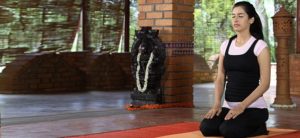After you have had a heavy weekend dinner, do you wonder what yoga pose can you strike to relieve the heaviness?
Experts at Sri Sri School of Yoga recommend just one posture that can be done post dinner- Vajrasana or the adamantine pose, also called the thunderbolt pose. The term comes from the combination of Vajra in Sanskrit meaning diamond shaped and Asana meaning pose. The origin lies in the shape that it resembles, when you get into the pose. Before we get into the immense benefits of this single pose, let us see how it is done!
How o do Vajrasana (Thunderbolt Pose)
- Get on the yoga mat and kneel down.
- Gradually place your hips on the heels.
- Toes should point out behind you. Make sure the big toes are touching each other.
- Make sure your sit-bones are placed squarely on the heels.
- The spine needs to be erect, head straight. The spine, neck and head are aligned.
- Palms are on the thighs, facing up.
- Take long deep breaths in the pose.
- Begin with sitting for a few minutes in the pose while breathing deeply.
- When can you practice it?
- Thunderbolt pose can be practiced after dinner, the only yoga pose that can be practiced on a heavy or full stomach. The pose can also be practiced while doing Pranayamas or breathing exercises.
Vajrasana Benefits
This pose stimulates the Vajra Nadi, one of the subtle energy channels that carry the life force throughout the body. Vajra Nadi is known to be associated with the sun and is located at the base of the spine (Mooladhara).
1) Practicing the pose improves digestion by balancing the digestive fire in the body. It relieves you from indigestion.
2) It also helps treat sciatic pain, when practiced over a long period of time.
3) Sitting in this pose, channels the flow of blood to your pelvic and abdominal region, helping work your bowel movement.
4) Relieves you of the excess gas formed
5) Strengthens the nerves in the legs, thigh and the spinal cord.
6) Helps prevent rheumatic disease.
7) During this practice, the spine is straightened. Thus aiding breathing practices by making them smoother and more efficient.
When Should You Not Do It?
- Acute trouble or stiffness in foot, ankle and knees.
- Slipped disc conditions.
- Those who have difficulty in movement should practice this asana with a lot of care
It is important to learn and practice yoga postures under the supervision of a trained Sri Sri Yoga teacher.










